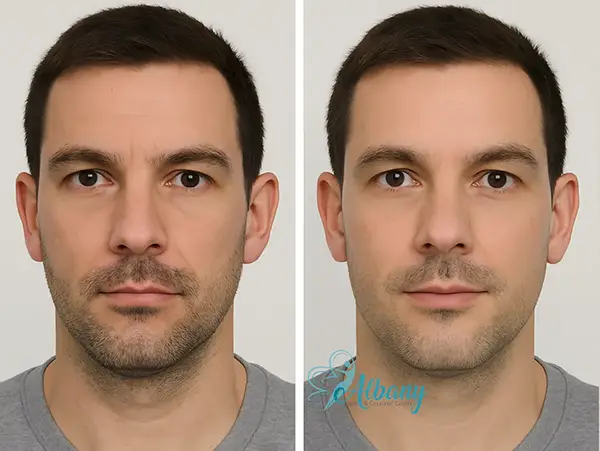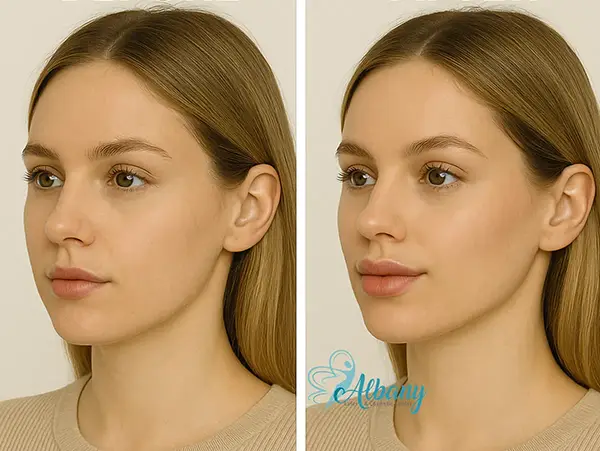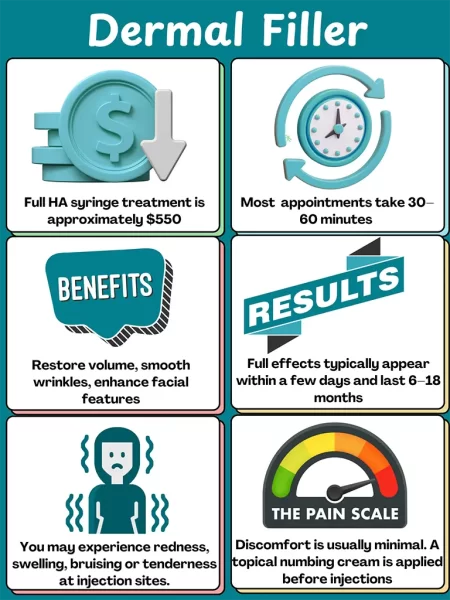Professional Dermal Fillers Edmonton
Dermal Filler Edmonton injections are minimally invasive treatments that restore volume, smooth lines, and refine facial contours in under an hour, with immediate results and minimal downtime.
Albany Cosmetic and Laser Centre offers advanced dermal fillers in Edmonton, using Health Canada–approved hyaluronic acid and biostimulatory options to lift the cheeks, define the jawline, enhance the lips, and soften the tear troughs and folds.



Dermal Filler Treatment Summary
Cost & Pricing
What To Expect
Mechanism of Action
Benefits & Results
Discomfort & Pain Level
Side Effects & Downtime

Fillers Pricing and Packages in Edmonton
The cost of fillers in Edmonton varies based on the type of filler and the desired results. At Albany Cosmetic and Laser Centre, we offer a range of high-quality, FDA-approved products tailored to meet various aesthetic goals. Below is the pricing for our most popular brands, depending on availability:
| Filler | Price |
|---|---|
| Juvederm Revanesse Restylane Hyaluronic acid gel |
One syringe $550
Two syringes $1,050 three syringes $1,500 |
| Radiesse | $800 per syringe |
| Sculptra Poly-L-lactic acid |
One vial $1,200
Two vials $2,000 Three vials $2,400 |
| Bellafill Collagen-Based |
One syringe $1,200
Two syringes $2,000 Three syringes $2,400 |
Why Choose Albany Cosmetics For Fillers Edmonton?
- Expert medical injectors: Skilled, conservative techniques for natural, balanced results.
- Personalized plans: Full-face assessment, facial balancing, and precise product selection.
- Premium products: Health Canada–approved HA and biostimulatory fillers matched to your goals.
- Safety first: Sterile protocol, needle/cannula choice, hyaluronidase on hand, HSV prophylaxis when indicated.
- Comfort-focused: Topical numbing, cooling, and clear aftercare to minimize downtime.
- Transparent pricing: Upfront quotes, staged plans, and realistic timelines.
- Measurable outcomes: Standardized photography to track progress and fine-tune.
- Comprehensive care: Thoughtful combos with Botox, skin treatments, and skincare for lasting results.
- Local convenience: Friendly team, flexible scheduling, and attentive follow-ups in Edmonton.
Book a personalized consultation to confirm candidacy and design your filler plan.
Ready for natural-looking enhancement? Book your fillers!
Take the next step with Albany Cosmetic & Laser Centre. Schedule a personalized consultation to assess your features, review goals and medical history, and map a safe, step-by-step plan. We’ll recommend the right product, dose, and technique (needle or cannula), discuss timelines around events, and provide transparent pricing and aftercare so you know exactly what to expect. Same-day treatment may be available when appropriate, or we can stage sessions for subtle, progressive results. Have questions about longevity, downtime, or combining fillers with Botox or skin treatments? We’ll tailor everything to you—reserve online or call to secure your spot.
Request Your Appointment Today
Request your consultation today and discover how our treatment can refresh your appearance.
Call us at (587) 520‑2835 or use our online booking form to schedule an appointment.
Read our privacy policy here
Frequently Asked Questions
What Are Fillers Edmonton and How Do They Work?
- Hyaluronic Acid (HA) – Hydrating and versatile for lips, cheeks, and lines (Juvederm, Revanesse, Teosyal). These fillers can be reversed with hyaluronidase for adjustments.
- Calcium Hydroxylapatite – Collagen-stimulating for firmer contours (Radiesse).
- Poly-L-lactic Acid (Sculptra) – Gradual collagen stimulation for longer-lasting facial rejuvenation.
- PMMA Microspheres (Bellafill) – Long-lasting filler for smile lines and acne scars, offering results that can last up to 5 years.
Who is a good candidate for fillers in Edmonton?
- You’re a strong candidate for dermal fillers if you want to restore volume, smooth etched lines, or sharpen facial contours with a quick, non-surgical treatment and minimal downtime.
- Ideal candidates are healthy adults with realistic expectations, a stable weight, and good skin care habits, including daily use of SPF.
- Please disclose medications, bleeding tendency, prior filler or surgery, and any allergies to hyaluronic acid or lidocaine.
- You can avoid unnecessary blood-thinning supplements before treatment, and you’ll follow after-care closely.
- Not ideal now: pregnancy or breastfeeding, active infection, cold sores on the lips, uncontrolled illness, or unrealistic goals.
- Please be aware of this when considering recent dental work, upcoming travel, or autoimmune flare-ups. A consultation confirms safety, product choice, and a plan tailored to your features and goals.
How Do I Prepare for Dermal Fillers?
- Plan timing: schedule two weeks away from major events.
- Dental work: avoid elective procedures two weeks before and after.
- Vaccines/illness: keep vaccines one week away; reschedule if sick or with a cold sore.
- HSV: for lip/perioral filler, ask about starting valacyclovir 1–2 days prior.
- Seven days before: avoid non-essential blood thinners/supplements; never stop anticoagulants without approval.
- 48–72 hours before: pause retinoids, AHAs/BHAs, benzoyl peroxide; no waxing/depilatories; hydrate and rest.
- 24 hours before: no alcohol or strenuous exercise; prepare a clean pillowcase.
- Day of: arrive clean-faced; eat a light meal; hydrate; wear loose clothing; bring meds list and questions.
- Expectations: mild swelling, redness, small bruises; follow aftercare.
- Urgent: severe pain, blanching, or vision changes—seek immediate help. Call the clinic if ever unsure.
What Areas Can Be Treated with Fillers Injections?
- Temples: Fill hollowing to support brow and soften a gaunt look.
- Cheeks: Restore midface volume, improve light reflection, and indirectly ease nasolabial folds.
- Tear troughs: Reduce hollows and shadows for a rested look.
- Nasolabial folds: Soften depth by supporting adjacent structures.
- Lips: Add volume, define borders, correct asymmetry, hydrate.
- Vertical lip lines: Smooth etched lines around the mouth.
- Marionette lines/corners: Lift downturned corners; lessen chin shadows.
- Chin: Improve projection/length; balance profile; smooth mental crease.
- Jawline/pre-jowl: Define angle; camouflage early jowling for a cleaner line.
- Nose (nonsurgical): Camouflage small humps; refine bridge/tip—expert injectors only.
- Hands: Replenish volume so veins/tendons appear less prominent.
- Select scars: Fill atrophic depressions; often paired with subcision/energy.
What Should I Do After Filler Treatment?
- Immediately: hands off; ice 10 min on/off; elevate; avoid makeup briefly.
- First 24 hours: no strenuous exercise, saunas, hot tubs, steam, hot yoga; no alcohol.
- Pain: use acetaminophen; avoid NSAIDs unless prescribed.
- Skincare: gentle cleanse, basic moisturizer; no retinoids, acids, exfoliation.
- 24–48 hours: swelling peaks; continue elevation/ice; lumps are swelling—don’t massage unless advised.
- Days 2–7: light exercise; avoid intense heat; resume actives after 48–72h.
- Treatments/pressure: no facials, peels, lasers, microneedling; avoid tight masks/goggles; postpone dental work two weeks.
- Weeks 2–3: book review for symmetry and fine-tuning.
- Urgent: severe pain, color change, coolness, numbness, vision symptoms—seek urgent assessment; follow instructions.
Botox vs. Dermal Fillers vs. Threads: What’s the Difference?
- Neuromodulators (e.g., Botox): Relax muscles to smooth “dynamic” wrinkles caused by facial expressions—such as frown lines, crow’s feet, and forehead furrows. Effects last about 3–4 months, helping prevent lines from forming when you smile or frown.
- Threads (PDO thread lift): Dissolvable sutures placed under the skin to gently lift and reposition tissue while stimulating collagen. Useful for early laxity in the cheeks, jawline, and brow. Expect a subtle, immediate lift with continued improvement over 3–6 months; results often last 12–18 months.
- Combination approach: Neuromodulators soften muscle-driven lines, fillers restore volume and shape, and threads provide lift and collagen stimulation for comprehensive facial rejuvenation.